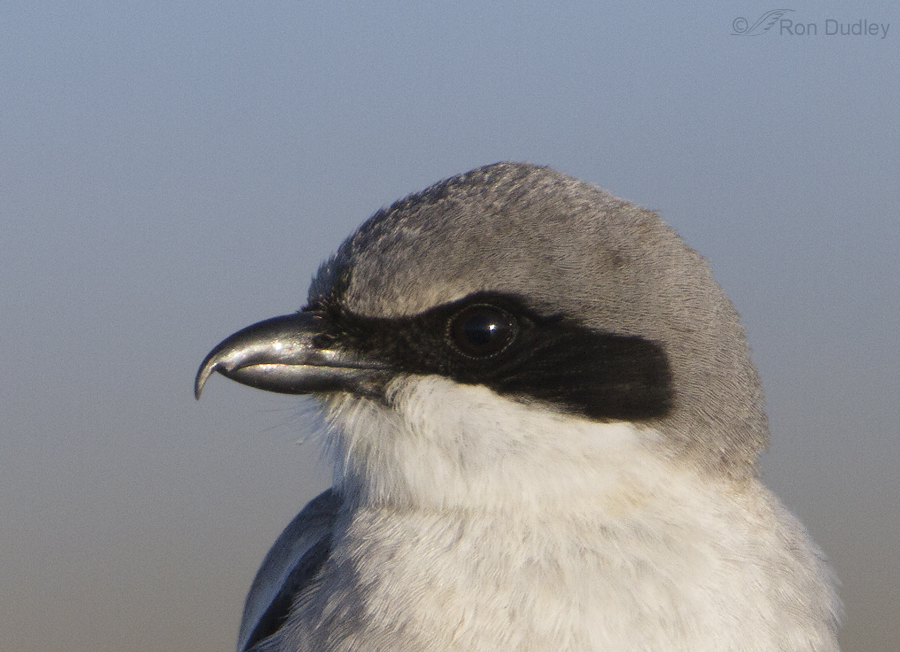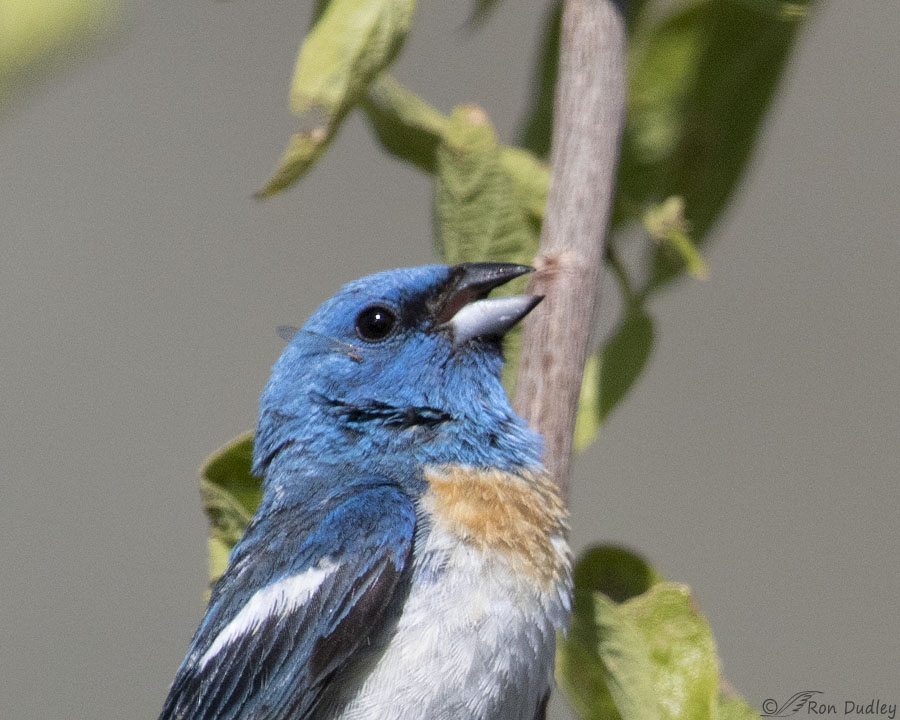It’s confusing.
When I’m discussing bird characteristics or pointing out field marks for species ID I often have to distinguish between the upper and lower parts of a bird’s beak. Two quick examples would be…

the tomial tooth (falcon tooth) on the upper part of the beak of a Loggerhead Shrike or…
the bicolored bill of the Lazuli Bunting (yes, that’s an insect wing stuck to the feathers behind and below his eye).
In both cases, and many others, it’s imperative to have terminology that distinguishes between the upper and lower parts of the beak (or bill, the terms are synonymous). In most vertebrates the lower jaw or jawbone (whether it’s made of bone or cartilage) is called the mandible and the upper jaw or jawbone is called the maxilla. As a retired biology and zoology teacher I’ve beaten that terminology into the heads of generations of students and so have countless other high school and college teachers around the world.
But in birds it’s different, at least usually. Their upper and lower jawbones are covered with a tough, lightweight protein called keratin and, apparently by convention, that difference called for slightly different terminology. In birds the lower part of the beak is generally called the lower mandible and the upper part is called the upper mandible. To many of us upper mandible seems self-contradictory but apparently it’s here to stay.
So, the Lazuli Bunting above is said to have a black upper mandible and a light blue (often appearing white) lower mandible. In birds the upper portion of the beak is typically not referred to as the maxilla (but sometimes it is).
I’m making kind of a big deal out of this because I often confuse some of my readers when I refer to the upper portion of a bird’s bill as the upper mandible instead of the maxilla. It isn’t unusual for readers of Feathered Photography, including former students of mine, to question my choice of terms in comments or private emails. It’s time consuming (and sometimes awkward) to repeatedly explain it all.
So now, whenever someone questions my terminology in this regard, I don’t have to take the time to explain it all again – all I have to do is provide a link to this post. And that’s exactly what I plan to do.
Just me being lazy I guess.
Ron



Huh. I just learned something. AGAIN! 😀 Thanks, professor.
Very welcome, Arwen.
Apropos of porcupine’s bar room brawl analogy: them’s fightin’ words, pardner. In these parts we learnt rostrum was the right name for those with anatomical learnin’. But to keep the peace and so as not to sound to uppity I use beak and bill, especially after a few shots of whiskey; or bullets.
“porcupine’s bar room brawl”
That got my attention, Lyle. I initially read it too fast and for a moment imagined porcupines fighting in a bar room. They’d certainly be well armed…
The terms are used so interchangeably in the literature that either one sounds correct to me, but only for birds. I don’t really know the reasons but the anatomy of bird is somewhat different than most vertebrates. The maxilla is fused or at least partially fused to the skull. This is less true of many birds. For many birds the maxilla is anchored to the skull but often less firmly and is often hinged to allow some movement. There are many obvious exceptions to this such as woodpeckers where it is firmly anchored or skimmers where it is the mandible that is firmly anchored to the skull allowing the maxilla to lift up. Parrots are very skillful at using the maxilla to get at food or as a climbing tool. I don’t really know if that diversity of using the maxilla and its flexibility account for the terminology differences but it’s a thought.
“it’s a thought”
And an interesting one, Dan. Thank you.
Thanks to you, I was able to ID both birds after seeing just the images. (I realize that isn’t much of a feat to experienced bird people, but for me it’s something. Just don’t ask me to ID any sparrows.😉)
As for this old anat/phys teacher, it’s going to be tough to let go of maxilla, but I can learn. (Upper mandible. Upper mandible. Upper mandible…)
I still have a hard time with it, Marty. But it’s finally getting a little easier.
Learning all the time – and with such beautiful illustrations too. Thank you. And how I wish that biology hadn’t been taught as a second rate science when I was at school… (not nearly as important as physics or chemistry). I disagreed then, I disagree now and personally find it MUCH more interesting.
As a retired biology teacher, I agree — squishy stuff is much more interesting. 😉
As do I, EC. It isn’t even a horse race. Although I must say that the life sciences and chemistry in particular are so intertwined it’s hard to separate them.
Thank you – was never 100% sure of those terms. Wish I had had you as my biology teacher.
I appreciate that, Everett.
Fun knowledge transfer today Ron! Glad to know (like others) that it has been fine to use ‘bill’ and ‘beak’ interchangeably.
Thanks, Kathleen.
I learned the hard way when banding Evening Grosbeaks! Yup, used gloves after that, thin gloves, but gloves just the same. To tell the truth Chickadees can hurt too, they seem to incessantly go for the skin around the finger nail.
Thanks for relating your experiences, Dick.
I’m just satisfied to know, now, that I can use “beak” and “bill” interchangeably
without sounding ignorant– thanks ! And I hope that a Loggerhead Shrike
doesn’t ever fasten on to me with his “upper mandible”………
Good!
Researchers often use gloves when handling shrikes, for the reason you’ve alluded to.
Now you have me digging through scientific literature. Anyone discussing the embryology and skeletal anatomy of birds uses the term Maxilla when referring to the upper jaw. The only time “upper mandible” appears is when someone is discussing the actual bill. It looks to me like “upper mandible” is a non-scientific term used synonymously with “upper bill”. The skeletal upper jaw is the maxilla.
Time to back away from the computer and go outside. You Ron, are like the guy who throws the first punch in a bar room brawl and then steps aside and watches!
“You Ron, are like the guy who throws the first punch in a bar room brawl and then steps aside and watches!”
Porcupine, I was just getting into my pickup after buying groceries this morning when I read your comment on my phone. You had me laughing all the way home!
Undoubtedly because in my day I’ve spent more time in Montana cowboy bars than I probably should have…
OK 😉 I may (or may not) keep the technical terms readily available for use in my brain tho I’m sure I’ll remember “something” is there about it! Thx for the anatomy lesson. 🙂 Tend to use “beak” for “birds” and “bill” for waterfowl just enjoying it all.
Thanks, Judy. Yeah, I use “bill” for waterfowl too.
I would love to know the history of “lower mandible”. Anatomically it seems ridiculous. Was it possibly a confused birder who started it and now we all just follow along? Kind of like John Audubon claiming vultures have no sense of smell? I refer to it a maxilla on birds and everyone listening to me knows exactly what I am talking about. Interesting discussion. I’m sure someone knows the reasons and history but I am like you, it makes no sense.
“Anatomically it seems ridiculous”
That’s exactly the reaction from some of my readers, Porcupine. But when I use “maxilla” others react the same way.
Thus today’s post.
Thanks for this excellent post. I have wondered why the terms “upper mandible” and “maxilla” are both used (for birds) by many speakers, writers, etc. Until now I have thought they are apparently interchangeable terms for the same part and that using one or the other was likely a preference of the speaker, writer, etc. Now I know better and appreciate that! I also appreciate and delight in your photo which shows an insect wing “stuck to the feathers behind and below” the Lazuli Bunting’s eye. Fantastic example of the details you show in your photos and share with us. Thanks for this blog, Ron.
Thank you, Kathy. Yes, at times both terms are used for the upper mandible but in most knowledgeable sources I’m aware of (including but not limited to Cornell’s Birds of the World) “upper mandible” is the term of choice.
Funny that your explanation arrived in my email today. Cause I’m cat-sitting this winter and for their entertainment, I show YouTube’s cat videos of hundreds of different kinds of birds at feeders which the kitties love to watch. And 2 days ago, we saw a bird at the feeder with a malformed lower beak, it was very long and crooked, but it ate side-ways like a scoop! Seemed healthy enough for its “disability” of a lower mandible.
Terri, bill anomalies are fairly common in birds. I’ve photographed a fair number of them, including in raptors.
Not only that, now I can stop worrying about whether it’s ‘beak’ or ‘bill.’ Instead, I can start pondering why I choose one term rather than the other at different times, since I do use both.
That insect wing is a wonderful little detail.
Shoreacres, I use beak and bill interchangeably too, although I probably use the former most.